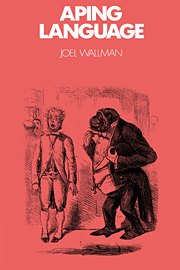7 - Language, evolution, and anatomy
Published online by Cambridge University Press: 03 November 2009
Summary
In case the preceding pages have not made this clear, I should state that I do not believe that any of the ape-language projects succeeded in instilling even a degenerate version of a human language in an ape. There are no persuasive data in support of syntactic patterning. At best, one or more of the animals in these studies acquired an ability, or enhanced an inchoate one, to represent things with symbols. However, the evidence for even this capacity, a prerequisite for syntactic productivity, is equivocal.
Is it absurd to consider the linguistic incompetence of apes as something requiring explanation? After all, no one would think to pose the question of, say, why Homo sapiens cannot fly, or why birds cannot swim. These questions are not asked because it is assumed that taxa separated by millions of years of evolution will differ in their adaptations, the extent of the divergence corresponding roughly to the length of that separation, barring parallel or convergent evolution. Given that our lineage diverged from the most closely related hominoid at the very least four million years ago, which separates us by eight million years of independent evolution, why is it thought likely by some that an ape species would possess a human faculty, especially an unused form of it?
The molecular geneticists King and Wilson (1975) presented an abundance of evidence that the structural proteins of humans and chimpanzees (Pan troglodytes), as well as the genes coding for those proteins, are 99 percent identical between the two species.
- Type
- Chapter
- Information
- Aping Language , pp. 109 - 127Publisher: Cambridge University PressPrint publication year: 1992



